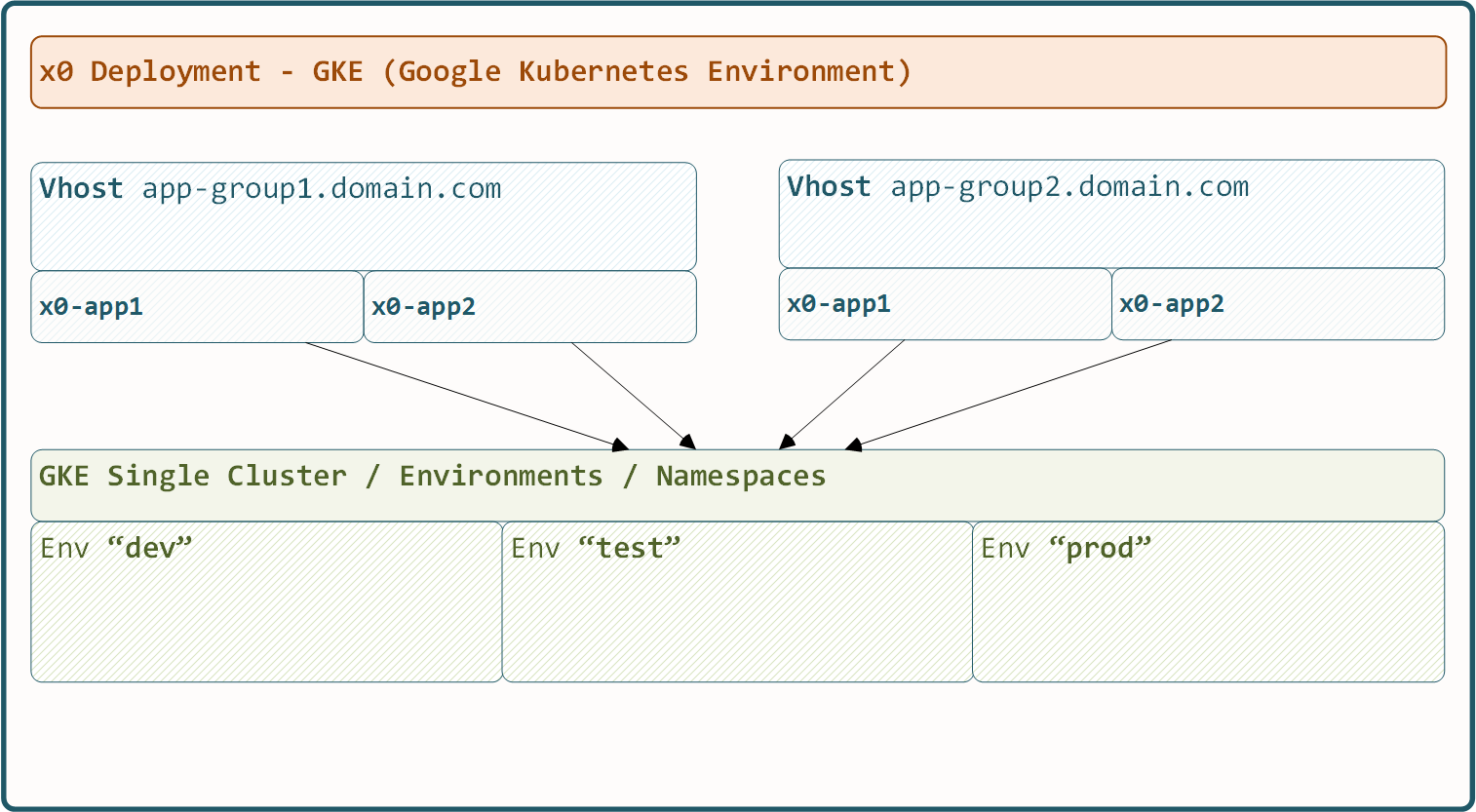21. Deployment
21.1. Intro
The x0-deployment main goal is to get multiple production ready GKE (Google Kubernetes Engine) environments online with minimum effort.
Why Kubernetes? It is the only current system worldwide guaranteeing native fail-safe operations including application load-balancing and auto-scaling.
Following, our proposed deployment workflow.
Run & Test Application in Docker Environment (x0-supported)
Deploy on Kubernetes Minikube (x0-supported)
Deploy to GKE Production Cluster (x0-supported)
Terraform Convert Metadata (x0-supported)
Takeover Lifecycle / DevOps Management by Terraform or similar
21.2. Standalone
Standalone installation provides packages for Ubuntu 22.04.
If you really like to run packages natively, install x0-app and x0-db .deb packages. Using the Docker environment is strongly recommended to avoid unnecessary effort.
dpkg -i x0-db_1.0_all.deb
dpkg -i x-app_1.0_all.deb
21.3. Docker
The x0-docker-environment is primarily intended to test your application locally before more time-consuming Kubernetes administration tasks apply.
A Minikube deployment also includes infrastructural / loadbalancing tests to ensure your application also behaves correctly on GKE.
21.4. Test Image / Container
To run tests transparently on any environment, the x0-infrastructure is completely dockerized.
The following steps will run all system tests:
Start Application Containers (x0-app, x0-db)
Start Selenium Server Container
Start Test-Runner Container
# start x0-app, x0-db containers
cd ./docker && ./x0-start-containers.sh
# start x0-app, x0-db containers
cd ../test
python3 ./run-selenium-server.py
sleep 10 && ./run-test-container.sh
21.5. Docker on Windows
Final built images / containers also run on Windows 11 (Docker Desktop)
Building on Windows 11 (Docker Desktop) is not possible
21.6. Kubernetes
The kubernetes installer will set up the following, depending on the configuration.
Kubegres / Multi-Pod PostgreSQL Database
Multi-Pod x0-application
Ingress-nginX Application Load-Balancing
It will set up multiple environments in different GKE namespaces with configurable DNS host / domain based Virtual Hosts and x0-applications.
Environments
Virtual Hosts
x0-Applications

The kubernetes installer is located at /kubernetes/setup/Setup.py.
Regardless of developing x0-base or your own app (x0-skeleton), the first step to check if your application runs on GKE is starting the setup for Minikube.
{
"installer": {
"type": "x0",
"subtype": "minikube",
"os": "mswindows",
"os_version": 11
}
}
# change to setup
cd ./kubernetes/setup/
# run installer
python3 ./Setup.py
21.6.1. Base Properties
Root properties.
Property |
Type |
Description |
|---|---|---|
project |
Object |
Project Properties (name, id, git-repo) |
installer |
Object |
Installer Properties (type) |
database |
Object |
Database Authentication Properties |
env_list |
Array of EnvStrings |
Environments List |
environments |
Object |
Environments Objects Declaration |
vhosts |
Object |
VHosts Object Declaration |
21.6.2. Project Properties
Project related properties.
Property |
Type |
Description |
|---|---|---|
name |
Identifier String |
Project Name |
id |
Identifier String |
Project ID (If different ID from name wanted) |
git-repo |
Git-Repo String |
Git Repository (Docker Registry Ref) |
21.6.3. Installer Properties
Installer related properties.
Property |
Type |
Description |
|---|---|---|
type (installer) |
Enum InstallerString |
“x0” or “debian-package” or “default” |
21.6.4. Database Properties
Database related properties.
Property |
Type |
Description |
|---|---|---|
name |
String |
Main System Database Name |
su_password |
DB-Password String |
Postgres Super User Password |
x0_password |
DB-Password String |
Web Application User Password used by x0 App |
repl_password |
DB-Password String |
Kubergres Replication Password |
21.6.5. Environment Element
Environment Element related properties.
Property |
Type |
Description |
|---|---|---|
$env.kubernetes |
Object |
Kubernetes Environment ID |
$env.kubernetes.deployment |
Object |
Deployment Properties |
$env.kubernetes.deployment.image |
String |
Docker Image ID |
$env.kubernetes.deployment.replicas |
Integer |
Pods Replica Count |
$env.kubernetes.deployment.cpu |
String |
CPU Percentage |
$env.kubernetes.deployment.memory |
String |
Memory Amount |
$env.kubernetes.deployment.autoscale |
Boolean |
Autoscaling Active |
$env.database |
Object |
Database Pod Properties |
$env.database.size |
String |
Single Pod Size |
$env.database.replicas |
Integer |
Pods Replica Count |
21.6.6. VirtualHost Element
Property |
Type |
Description |
|---|---|---|
$vhost.apps |
Array of AppStrings |
List of x0-Applications |
$vhost.env |
Object |
Environments Config |
$vhost.env.$env |
Object |
Environment ID |
$vhost.env.$env.dns |
Object |
DNS Properties |
$vhost.env.$env.dns.hostname |
String |
DNS Hostname |
$vhost.env.$env.dns.domain |
String |
DNS Domain |
$vhost.env.$env.ip |
Object |
IP Properties |
$vhost.env.$env.ip.v4.dns_register |
Boolean |
IPv4 Register DNS |
$vhost.env.$env.ip.v4.dns_register_type |
String |
IPv4 Register DNS Type |
$vhost.env.$env.tls |
Object |
TLS Properties |
$vhost.env.$env.tls.certs |
Object |
Certificate Properties |
$vhost.env.$env.tls.certs.ca-cert |
CertID-String |
CA Cert Reference |
$vhost.env.$env.tls.certs.cert |
CertID-String |
Cert Reference |
$vhost.env.$env.tls.certs.key |
CertID-String |
Cert Private Key Reference |
$vhost.env.$env.tls.verify-client-certs |
Boolean |
Ingress-nginx Verify Client Certs |
$vhost.env.$env.loadbalancer |
Object |
Loadbalancer (ingress-nginx) |
$vhost.env.$env.loadbalancer.ref |
String |
Ingress Reference |
$vhost.env.$env.loadbalancer.paths |
Array of Strings |
List of Ingress Paths |
$vhost.env.$env.whitelist-source |
IPv4Net-String |
Whitelist IP / Subnet |